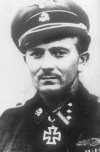Hermann Buchner (SS officer)
| Hermann Buchner | |
|---|---|
 | |
| Born |
16 January 1917 Nürnberg |
| Died |
17 November 1944 (aged 27) Killed in action near Modlin, Poland |
| Allegiance |
|
| Service/branch |
|
| Years of service | 1933–44 |
| Rank | Sturmbannführer |
| Unit | 3rd SS Panzer Division Totenkopf |
| Battles/wars | World War II |
| Awards |
Knight's Cross of the Iron Cross German Cross in Gold Close Combat Clasp in Gold Iron Cross 1st Class Iron Cross 2nd Class Infantry Assault Badge in Silver Wound Badge in Gold Eastern Front Medal Demyansk Shield War Merit Cross with Swords Tank Destruction Badge in Silver [1] |
Hermann Buchner (16 January 1917 – 17 November 1944) was a Sturmbannführer (Major), in the Waffen SS during World War II who was awarded the Knight's Cross of the Iron Cross, which was awarded to recognize extreme battlefield bravery or successful military leadership by Nazi Germany during World War II. He was also one of only 631 men awarded the very rare Close Combat Clasp in Gold.[1][2]
Early Life and SS Career
Hermann Buchner was born Jan. 16, 1917. He attended college to be a pharmacist, and eventually joined the Waffen-SS. He enlisted in the SS on October 4. 1937, at the rank of SS-Anwarter. He was promoted to SS-Sturmman on 20. December, 1937. He attended officer candidate school, but dropped out once, and barely passed his second attempt.
Totenkopf, Demjansk and Russia
After graduation, he was assigned to SS-Totenkopf-Infanterie-Regiment 1. He served as an adjutant to 3. Battalion through the campaigns in France, and saw combat, winning the Iron Cross 2 Class. In the early parts of Operation Barbarossa he was involved in heavy close combat fighting. During the Demjansk encirclement he was again in close combat, and was wounded by shrapnel, but returned to his unit. He was awarded the Demjansk shield. He also recorded many days of close combat or "melee days."
When he earned the Knight's Cross he was the 3. Battalion Kommandeur. He led an infantry attack on a heavily defended position without any heavy armor or artillery support. He not only succeeded, but took comparatively minimal casualties, and hundreds of Russian prisoners. He was also awarded the Tank Destruction Badge, German Cross in Gold, the Wound Badge in Gold and the rare Close Combat Clasp in Gold.
Fate
He was one of few men in the entire German army to be awarded every single bravery medal. He was also the 4th member of the German armed forces to win the prestigious Close Combat Clasp in Gold, eventually recording over 60 "melee days" or days spent in close combat. In July and August 1943 alone, he recorded 20 days of melee.
He was killed in action, West of Warsaw in November 1944, when he was hit in the back by shrapnel.
Although he did poorly in his officer classes, he was still promoted quickly, and ended the war as a Major, or SS-Sturmbannfuhrer. He also was one of few SS Knight's Cross Winners who never joined the Nazi Party, and opposed many of Hitler's policies. His quick climb up the ladder is a testament to his excellent service with SS-Division "Totenkopf".
Awards
- Iron Cross First Class
- Iron Cross Second Class
- Infantry Assault Badge in Silver
- Wound Badge in Gold
- Eastern Front Medal
- Demyansk Shield
- Tank Destruction Badge in Silver
- Close Combat Clasp
- German Cross in Gold on 22 November 1942 as SS-Hauptsturmführer in 9./SS-Totenkopf-Infanterie-Regiment 1[4]
- Knight's Cross of the Iron Cross on 16 June 1944 as SS-Hauptsturmführer and commander of the III./SS-Panzergrenadier-Regiment 5 "Totenkopf"[5][Note 1]
Promotions
- SS-Sturmmann - 20. Dez. 1937
- SS-Junker - 1. Apr. 1938
- SS-Standartenoberjunker - 11. Sept. 1938
- SS-Untersturmfuhrer - 20. Apr. 1939
- SS-Obersturmfuhrer - 20. Apr. 1941
- SS-Hauptsturmfuhrer - 21. Jun. 1942
- SS-Sturmbannfuhrer - 29. Juli. 1944
Commands
- 9th Company, SS Totenkopf
- III. Battalion, 5th SS Panzer Grenadier Regiment Totenkopf
- II. Battalion, 5th SS Panzer Grenadier Regiment Totenkopf [1]
Notes
References
- Citations
- Bibliography
- Berger, Florian (2004). Ritterkreuzträger mit Nahkampfspange in Gold [Knight's Cross Bearers with the Close Combat Clasp in Gold] (in German). Vienna, Austria: Selbstverlag Florian Berger. ISBN 978-3-9501307-3-7.
- Fellgiebel, Walther-Peer (2000). Die Träger des Ritterkreuzes des Eisernen Kreuzes 1939–1945 – Die Inhaber der höchsten Auszeichnung des Zweiten Weltkrieges aller Wehrmachtteile [The Bearers of the Knight's Cross of the Iron Cross 1939–1945 — The Owners of the Highest Award of the Second World War of all Wehrmacht Branches] (in German). Friedberg, Germany: Podzun-Pallas. ISBN 978-3-7909-0284-6.
- Henschler Henri & Fay Will, Armor Battles of the Waffen-SS, 1943-45 Stackpole Books, 2003. ISBN 0-8117-2905-2.
- Kurowski Franz, Infantry Aces, Stackpole Books, 2005, ISBN 0-8117-3202-9
- Mitcham, Jr.Samuel, Retreat to the Reich, Stackpole books 2007. ISBN 0-8117-3384-X
- Patzwall, Klaus D.; Scherzer, Veit (2001). Das Deutsche Kreuz 1941 – 1945 Geschichte und Inhaber Band II [The German Cross 1941 – 1945 History and Recipients Volume 2] (in German). Norderstedt, Germany: Verlag Klaus D. Patzwall. ISBN 978-3-931533-45-8.
- Scherzer, Veit (2007). Die Ritterkreuzträger 1939–1945 Die Inhaber des Ritterkreuzes des Eisernen Kreuzes 1939 von Heer, Luftwaffe, Kriegsmarine, Waffen-SS, Volkssturm sowie mit Deutschland verbündeter Streitkräfte nach den Unterlagen des Bundesarchives [The Knight's Cross Bearers 1939–1945 The Holders of the Knight's Cross of the Iron Cross 1939 by Army, Air Force, Navy, Waffen-SS, Volkssturm and Allied Forces with Germany According to the Documents of the Federal Archives] (in German). Jena, Germany: Scherzers Miltaer-Verlag. ISBN 978-3-938845-17-2.
| |||||||||||||||||||||||||||||||||||||||||||||||||||||||||||||||||||||
